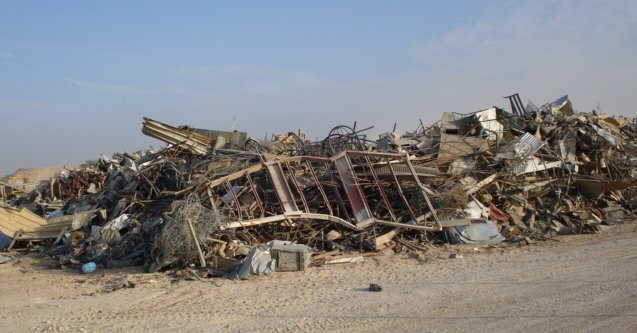
Anything you have “too much of” is not a problem; it is an opportunity. In Iraq, junk opportunities abound. In an earlier post I talked about the strange cases of sophisticated jet fighter planes strewn randomly around the desert. They are just some of the more unusual components of a very large junk pile that is Iraq.
Debris piles are nothing new here. Until 200 years ago, people were only vaguely aware of the great civilizations of Mesopotamia. French and British archeologist were much more interested in learning about them than the people nearby and it was not until they got here that anybody started to study the big mounds of dirt and rubble that formed the most prominent hills in an otherwise pancake flat landscape between the Tigris and Euphrates rivers. The ancient Mesopotamians built with mud brick. When structures were no longer worth repairing, they just smoothed them down and built on top, ashes to ashes, dust to dust. Over time, town elevations increased. Each layer from a different time, so keeping track of precisely where particular artifacts were found makes a difference for the chronology. Before the 19th century archeologists arrived, people plundered the mounds for treasure and building materials, but rarely paid attention to the context. As a kid fascinated by ancient history, I was puzzled that anybody could be so dismissive of the past. I am beginning to understand, if not accept that perspective.
Heaps of junk and garbage are everywhere. Most is the detritus of recent civilization. Modern people produce more rubbish than their ancestors did and the materials are different. Mud bricks made of dirt, pottery shards made of dirt and artifacts made of dirt are not that different from the dirt they are piled on. In fact most people probably thought they were just dirt piles. Nevertheless, trash of all kinds persists in the desert. In humid climates, metal rusts; wood rots and minerals dissolve. Above all, growing vegetation soon covers any garbage pile, integrating it into the living environment or at least obscuring the view. Not here. In Anbar integration processes anticipate the advent of the next ice age to do their work and bide their time until then.
Trash heaps are so ubiquitous that you stop paying attention, even if digging in them might reveal history. I suppose the native population of the region just became inured to them, as I have. The first nearly complete Soviet MiG lying in the desert is interesting. After a while they become about as remarkable as a derelict car on blocks outside a trailer park. The types of junk below the fighter jet in the pecking order of interest fall even faster.
We need to make a distinction between junk, trash, garbage and scrap, BTW. Scrap can be very valuable, especially with prices rising as the worldwide demand for metal climbs. The Iraqis may not be sitting on a gold mine, but their scrap heaps are mines for all sorts of other metals. The Iraqi government figured this out and outlawed the export of scrap. They want to keep it here. Rebuilding Iraq will require lots of girders and rebar.
Some of the best scrap is the wreckage of war. Good metal goes into weapons systems. Wreckage of war is maybe not exactly right. Saddam enriched Soviet, French and Chinese arms merchants buying war materials that he never properly used. Everybody would have been better off is Saddam had just brought scrap from the Soviets or the Chinese and dumped it directly w/o the intervening steps. There is no American scrap in Saddam era scrap piles.
The widely held misconception that U.S. firms armed Saddam is …a misconception. In actual fact, the U.S. supplied only 0.47% of his vast arsenal. That is ZERO point four seven and that is why there is no pre-2003 U.S. scrap. But we are making up for it now. Our big bases feature big junk yards, but the difference is that U.S. owned scrap can be exported, so these junk yards are going concerns. Iraqi scrap stays here.
Iraq lacks the capacity to reprocess its iron mountains. This is an opportunity, not a problem. I can only imagine how fast a mini-mill company like Nucor could turn that junk into useful building material, but if they built a modern factory in Iraq, what would they do when they had worked through the supply? There is already an overcapacity of steel production worldwide. Since Iraq has no significant iron ore deposits and these giant piles of scrap will not last very long if efficiently processed, perhaps it makes more sense to export the scrap and import the metal. Somehow I doubt that good sense solution will be the one chosen. Everybody wants to be in the steel business. Unfortunately not everybody can make money at it.
